Lower Manhattan
Lower Manhattan
Downtown Manhattan, Downtown New York City | ||
|---|---|---|
ZIP Codes 10004, 10005, 10006, 10007, 10038, 10280, 10012, 10013, 10014 | ||
| Area code(s) | 212, 332, 646, and 917 | |
| Median household income | $201,953 | |
Lower Manhattan, also known as Downtown Manhattan or Downtown New York, is the southernmost part of
Despite various definitions of Lower Manhattan, they generally include all of
Geography
Lower Manhattan is delineated on the north by 14th Street, on the west by the Hudson River, on the east by the East River, and on the south by New York Harbor. Its northern border is designated by thoroughfares about a mile-and-a-half south of 14th Street and a mile north of Manhattan's southern tip around Chambers Street near the Hudson River east of the entrances and overpass to the Brooklyn Bridge.[5] Two other major arteries to Lower Manhattan are Canal Street, roughly half a mile north of Chambers Street, and 23rd Street, roughly half a mile north of 14th Street.
Lower Manhattan's
The
History
Lenape and New Netherland
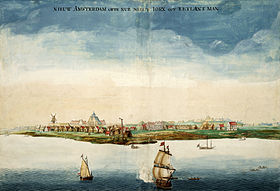
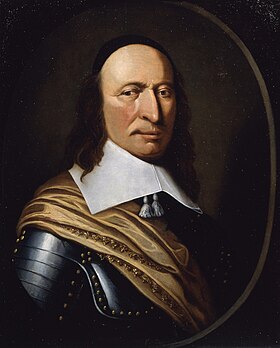
The area that would eventually encompass modern-day New York City was inhabited by the Lenape people. These groups of culturally and linguistically identical Native Americans who spoke an Algonquian language now referred to as Unami.
European settlement began with the founding of a Dutch fur trading post in Lower Manhattan, later called New Amsterdam (Dutch: Nieuw-Amsterdam) in 1626.[8][9] The first fort was built at The Battery to protect New Netherland.[10]
In approximately 1626, construction of
On May 27, 1647,
17th and 18th centuries
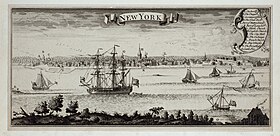
In 1664, the English conquered the area and renamed it "New York" after the Duke of York and the city of York in Yorkshire.[13][14]
At that time, people of African descent made up 20% of the population of the city, with European settlers numbering approximately 1,500,[15]: 14 and people of African descent numbering 375 (with 300 of that 375 enslaved and 75 free).[15]: 22 While it has been claimed that African slaves comprised 40% of the small population of the city at that time,[16] this claim has not been substantiated. During the mid-1600s, farms of free blacks covered 130 acres (53 ha) where Washington Square Park later developed.[17]
The Dutch
The new English rulers of the formerly Dutch New Amsterdam and New Netherland renamed the settlement back to New York. As the colony grew and prospered, sentiment also grew for greater autonomy. In the context of the Glorious Revolution in England, Jacob Leisler led Leisler's Rebellion and effectively controlled the city and surrounding areas from 1689 to 1691, before being arrested and executed.
By 1700, the Lenape population of New York had diminished to 200.[18] By 1703, 42% of households in New York had slaves, a higher percentage than in Philadelphia or Boston.[19]
The 1735
By the 1740s, with expansion of settlers, 20% of the population of New York were slaves, totaling about 2,500 people.[20] After a series of fires in 1741, the city became panicked that blacks planned to burn the city in a conspiracy with some poor whites. Historians believe their alarm was mostly fabrication and fear, but officials rounded up 31 blacks and 4 whites, all of whom were convicted of arson and executed. City officials executed 13 blacks by burning them alive and hanged 4 whites and 18 blacks.[21]
In 1754, Columbia University was founded under charter by George II of Great Britain as King's College in Lower Manhattan.[22]
The
In 1771,
New York City was greatly damaged twice by
Starting in 1785, the
19th century

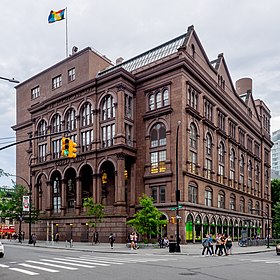
New York grew as an economic center, first as a result of
In 1898, the modern
20th century
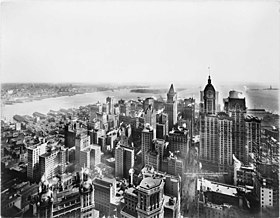

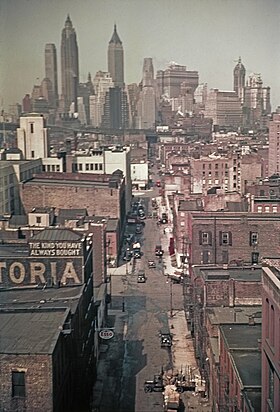
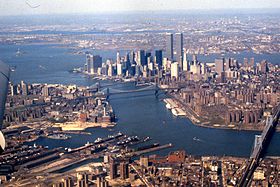
Washington Market was located between
Construction boom
Lower Manhattan retains the most irregular street
Despite these road connections opening, the economic center of New York City began to shift from Lower Manhattan to
On March 25, 1911, the Triangle Shirtwaist Factory fire in Greenwich Village took the lives of 146 garment workers, which would eventually lead to great advancements in the city's fire department, building codes, and workplace regulations.
Throughout the first half of the 20th century, New York became a world center for industry, commerce, and communication. Interborough Rapid Transit, the first New York City Subway company, began operating in 1904. The area's demographics stabilized, labor unionization brought new protections and affluence to the working class, the city's government and infrastructure underwent a dramatic overhaul under Fiorello La Guardia, and his controversial parks commissioner, Robert Moses, ended the 'blight' of many tenement areas, by demolishing slums, factories, and working-class neighborhoods through public works such as the High line, the West Side Highway and FDR Drive, built housing projects, expanded new parks, rebuilt streets, and zoning controls, especially in Lower Manhattan. The zoning changes were intended to displace the industrial workforce by removing zoning protection for industrial space and incentivizing upscale residential and clerical redevelopment. The port of New York, despite its physical suitability for berthing and its close proximity to Europe, began to deteriorate due to the city's unwillingness to invest or modernise the port and the deindustrialization zoning policy. However a large number of small scale, dynamic, and highly specialized industries persisted despite the city's efforts such as the garment industry which was closely tied to the fashion industry in Midtown, or the printing industry; linked with the publishing industry.
In the 1950s, a few new buildings were constructed in Lower Manhattan, including an 11-story building at 156 William Street in 1955.
When
Through much of its history, the area south of Chambers Street was mainly a commercial district, with a small population of residents—in 1960, it was home to about 4,000.[43] Construction of Battery Park City, on landfill from construction of the World Trade Center, brought many new residents to the area. Gateway Plaza, the first Battery Park City development, was finished in 1983. The project's centerpiece, the World Financial Center, consists of four luxury highrise towers. By the turn of the century, Battery Park City was mostly completed, with the exception of some ongoing construction on West Street. Around this time, Lower Manhattan reached its highest population of business tenants and full-time residents.[citation needed] These developments struggled to become fully occupied at desirable rents, with relatively high vacancy rates.[44]
In 1993, the Downtown Lower Manhattan Association contributed to a city plan calling for the revitalization of Lower Manhattan. The plan included recommended zoning changes, tax incentives to encourage new tenants, and the conversion of commercial buildings into apartments. It also called for the creation of a business improvement district, called The Alliance for Downtown New York, to help spur the area's renewal. Between 1995 and 2014, 15.8 million square feet of office space was converted to residential or hotel use. As a result, Lower Manhattan's residential population rose from 14,000 to 60,000.[45]
Culture
Since the early-20th century, Lower Manhattan has been an important center for the arts and leisure activities.
21st century



In the early 21st century, the Meatpacking District, once the sparsely populated province of after-hours BDSM clubs and transgender prostitutes, gained a reputation as New York City's trendiest neighborhood.[46]
September 11 attacks
During the September 11 attacks in 2001, two of four hijacked planes were flown into the Twin Towers of the original World Trade Center, and the towers collapsed. The 7 World Trade Center was not struck by a plane but uncontrolled fires that were caused by falling debris resulted in the building's collapse; a first in the history of steel framed skyscrapers.[47] The 3, 4, 5, and 6 World Trade Center buildings were damaged beyond repair or destroyed, and soon after demolished. The collapse of the Twin Towers also caused extensive damage to surrounding buildings and skyscrapers in Lower Manhattan. A total of 2,753 people, including those on the planes, were killed in New York.[48] About 400,000 people, including rescue workers and residents of the area were exposed to toxic dust and debris; many developed serious respiratory illnesses, cancers, and other harms arising from the attack, and 3,496 died.[49]
Post-9/11 rebuilding
Following September 11, Lower Manhattan lost much of its economy and office space but has since rebounded significantly. Private sector employment reached 233,000 at the end of 2016, the highest levels since the end of 2001. This was largely due to growth and diversification in the local workforce with gains in employment sectors like Technology, Advertising, Media and Information, as well as Hotel, Restaurants, Retailing, and Health care.[50] As of 2016, Lower Manhattan's business district is home to approximately 700 retail stores and 500 bars and restaurants.[51]
The
The
On October 29 and 30, 2012,
Lower Manhattan has been experiencing a baby boom, well above the overall birth rate in Manhattan, with the area south of Canal Street witnessing 1,086 births in 2010, 12% greater than 2009 and over twice the number born in 2001.[57] The Financial District alone has witnessed growth in its population to approximately 43,000 as of 2014, nearly double the 23,000 recorded at the 2000 Census.[58]
There are currently 61,000 residents in the Financial District of Lower Manhattan south of Chambers Street[59] and more than 62 percent of the population is between 18 and 44. Lower Manhattan is home to more young professionals than Greenpoint, the East Village, and Downtown Brooklyn and on par with Downtown Jersey City and Williamsburg.[60]
In June 2015, The New York Times wrote that Lower Manhattan's dining scene was experiencing a renaissance.[61] There are over 400 casual dining and more than 100 full-service dining restaurants in the area.[62] The Village Voice, based at 80 Maiden Lane in the Financial District and historically the largest alternative newspaper in the United States, announced in 2017 that it would cease publication of its print edition and convert to a fully digital venture.[63]
On October 31, 2017, a man drove a pickup truck into the Hudson River Park's bike path between Houston Street and Chambers Street, killing eight people and injuring at least 15.[64] Most of those who were hit were bicyclists. It was the first deadly terrorist attack in Manhattan since 9/11.[65][66]
Since 2010, a Lower Manhattan community known as
Historical sites
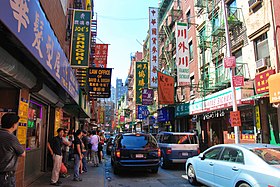
Before the
Lower Manhattan contains many more historical buildings and sites, including
In 1966, the commercial district of Radio Row on Cortlandt Street was demolished to make way for construction of the former World Trade Center.
Denotation
Downtown in the context of Manhattan, and of New York City generally, has different meanings to different people, especially depending on where in the city they reside. Residents of the island or of
As reflected in popular culture, "Downtown" in Manhattan has historically represented a place where one could "forget all your troubles, forget all your cares, and go Downtown," as the lyrics of Petula Clark's 1964 hit "Downtown" celebrate (although Tony Hatch, the songwriter of the track, later clarified that he naively believed Times Square to be "downtown," and was the actual inspiration for the hit single). The protagonist of Billy Joel's 1983 hit "Uptown Girl" contrasts himself (a "downtown man") with the purportedly staid uptown world.[72] Likewise, the chorus of Neil Young's 1995 single "Downtown" urges "Let's have a party, downtown all right."
Economy
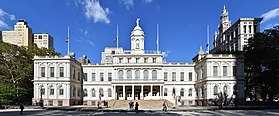
Lower Manhattan is the third-largest business district in the United States, after
Other large companies with headquarters in Lower Manhattan include (in alphabetical order):
- AIG, 175 Water Street[84]
- Ambac Financial Group[85]
- AOL, at 770 Broadway[86]
- BARKER, 30 Broad Street[87]
- Condé Nast, One World Trade Center, publisher of Vogue, W, Vanity Fair, The New Yorker, and other publications[88]
- Standard & Poor's, at 55 Water Street[89][90] HIP Health Plan of New York, which became a part of EmblemHealth, moved there with 2,000 employees in October 2004. It was the largest corporate relocation in downtown Manhattan following the September 11 attacks.[91]
- Goldman Sachs, at 200 West Street
- Group M, 3 World Trade Center[92]
- Hudson's Bay Company, Brookfield Place, the parent company of Saks, Lord and Taylor and Gilt Groupe[93]
- IBT Media, publisher of the International Business Times and Newsweek, among other publications; located in Hanover Square
- PR Newswire, at 350 Hudson Street[96]
- Spotify, 4 World Trade Center[97]
- 140 West Street[98]
Prior to the September 11 attacks, One World Trade Center served as the headquarters of Cantor Fitzgerald.[99] Prior to its dissolution, the headquarters of US Helicopter were in Lower Manhattan.[100] When Hi Tech Expressions existed, its headquarters were in Lower Manhattan.[101][102]
Government and infrastructure
Subway
The headquarters of the Port Authority of New York and New Jersey is located in 4 World Trade Center of the World Trade Center complex.[103]
The city hall and related government infrastructure of the City of New York are located in Lower Manhattan, next to City Hall Park. The
Many
Vehicles
Lower Manhattan is accessible by vehicle through several major thoroughfares. From New Jersey, Lower Manhattan is accessible through the Holland Tunnel from Interstate 78. From Queens, Long Island, and points east, it is accessible through the Queens–Midtown Tunnel from the Long Island Expressway. From Midtown and Upper Manhattan, it is accessible from the West Side Highway.
Bus
Many
See also
- East Side
- Lower East Side
- Lower West Side
- Midtown Manhattan
- Upper Manhattan
- West Side
References
- ^ a b "The Global Financial Centres Index 35". Long Finance. March 21, 2024. Retrieved March 23, 2024.
- ^ a b Russell Shorto (June 20, 2023). "A Walk Through the Past in New York". The New York Times. Retrieved August 19, 2023.
- ^ "A Growing Market: Lower Manhattan's Young, Educated & Affluent Residents". Downtown Alliance. May 16, 2023. Retrieved August 20, 2023.
- ^ "The BroadsheetDAILY – 2/22/22 – Lower Manhattan's Local Newspaper – Lower Manhattan Is Fourth-Fastest Growing Community in NYC". February 22, 2022. Retrieved August 20, 2023.
- ^ "District Information". Downtown Alliance. Archived from the original on January 30, 2020. Retrieved August 16, 2017.
- ^ "Chinatown New York". Civitatis New York. Archived from the original on April 4, 2020. Retrieved March 23, 2024.
As its name suggests, Chinatown is where the largest population of Chinese people live in the Western Hemisphere.
- ^ * "Chinatown New York City Fact Sheet" (PDF). www.explorechinatown.com. Archived (PDF) from the original on May 28, 2005. Retrieved March 23, 2024.
- Sarah Waxman. "The History of New York's Chinatown". Mediabridge Infosystems, Inc. Archived from the original on May 25, 2017. Retrieved March 23, 2024.
Manhattan's Chinatown, the largest Chinatown in the United States and the site of the largest concentration of Chinese in the Western Hemisphere, is located on the Lower East Side.
- David M. Reimers (1992). Still the golden door: the Third ... – Google Books. Columbia University Press. ISBN 9780231076814. Archivedfrom the original on November 3, 2023. Retrieved April 11, 2016.
- Lawrence A. McGlinn, Department of Geography SUNY-New Paltz. "Beyond Chinatown: Dual immigration and the Chinese population of metropolitan New York City, 2000, Page 4" (PDF). Middle States Geographer, 2002, 35: 110–119, Journal of the Middle States Division of the Association of American Geographers. Archived from the original (PDF) on October 29, 2012. Retrieved March 23, 2024.
- David M. Reimers (1992). Still the golden door: the Third ... – Google Books. Columbia University Press. ISBN 9780231076814. Archivedfrom the original on November 3, 2023. Retrieved March 23, 2024.
- Sarah Waxman. "The History of New York's Chinatown". Mediabridge Infosystems, Inc. Archived from the original on May 25, 2017. Retrieved March 23, 2024.
- ^ "United States History – History of New York City, New York". Online Highways LLC. Retrieved July 20, 2014 – via www.u-s-history.com.
- ^ Rankin, Rebecca B.; Rodgers, Cleveland (1948). New York: the World's Capital City, Its Development and Contributions to Progress. Harper.
- ^ a b "The Battery Highlights : NYC Parks". New York City Department of Parks and Recreation. Retrieved March 2, 2019.
- ^ a b Ellis, Edward Robb (1966). The Epic of New York City. Old Town Books.
- ^ Scheltema, Gajus and Westerhuijs, Heleen (eds.),Exploring Historic Dutch New York. Museum of the City of New York/Dover Publications, New York 2011.
- JSTOR 550138.
- ISBN 0-8050-7842-8.
- ^ ISBN 978-0226317731.
- ^ Spencer P.M. Harrington, "Bones and Bureaucrats", Archeology, March/April 1993, accessed February 11, 2012.
- ^ Rothstein, Edward (February 26, 2010). "A Burial Ground and Its Dead Are Given Life". The New York Times. Archived from the original on March 2, 2010. Retrieved March 1, 2010.
- ^ "Gotham Center for New York City History" Archived December 29, 2008, at the Stanford Web Archive Timeline 1700–1800.
- ^ "The Hidden History of Slavery in New York". The Nation. Archived from the original on May 30, 2006. Retrieved February 11, 2008.
- ^ Rothstein, Edward (February 26, 2010). "A Burial Ground and Its Dead Are Given Life". The New York Times. Retrieved March 1, 2010.
- ISBN 0-451-62600-1.
- ^ Moore, Nathaniel Fish (1876). An Historical Sketch of Columbia College, in the City of New York, 1754–1876. Columbia College. p. 8.
- ^ "A Public Market for Lower Manhattan" (PDF). New York City Council. Archived from the original (PDF) on January 26, 2007.
- ^ "The People's Vote: President George Washington's First Inaugural Speech (1789)". U.S. News & World Report. Archived from the original on September 25, 2008. Retrieved May 28, 2007.
- ^ Bridges, William (1811). Map of the City of New York and Island of Manhattan with Explanatory Remarks and References.
- ^ Lankevich (1998), pp. 67–68.
- ISBN 0-8232-1245-9.
- ^ The 100 Year Anniversary of the Consolidation of the 5 Boroughs into New York City, New York City. Retrieved June 29, 2007.
- ^ Jackson, Kenneth (1995). Encyclopedia of New York City. New Haven: Yale University Press. p. 206. "[B]orough presidents ... responsible for local administration and public works."
- ^ Bryan van Gorder (October 22, 2018). "The Queer History (and Present) of NYC's Village Halloween Parade". Logo TV. Retrieved November 12, 2022.
- ^ Millstein, Gilbert (April 24, 1960). "Restless Ports for the City's Food". The New York Times.
- ISSN 0362-4331. Retrieved January 10, 2023.
- ISSN 0362-4331. Retrieved December 24, 2017.
- ISSN 0362-4331. Retrieved May 9, 2018.
- ^ Ingraham, Joseph C. (May 26, 1950). "Brooklyn Tunnel Costing $80,000,000 Opened By Mayor". The New York Times. Archived from the original on September 2, 2017. Retrieved March 6, 2010.
- from the original on April 11, 2018. Retrieved May 23, 2018.
- ISSN 0362-4331. Retrieved August 16, 2009.
- ISSN 0033-8826.
- ^ a b Bartnett, Edmond J. (December 25, 1960). "Building Activity Soars Downtown". The New York Times.
- ISBN 0-7838-9785-5.
- ^ Iglauer, Edith (November 4, 1972). "The Biggest Foundation". The New Yorker.
- ^ ASLA 2003 The Landmark Award, American Society of Landscape Architects. Accessed May 17, 2007.
- ^ a b Brown, Charles H. (January 31, 1960). "'Downtown' Enters a New Era". The New York Times.
- ^ Henry, Diane (January 31, 1982). "City's Office Market Stabilizes After Post-Recession Surge". The New York Times.
- ^ "Lower Manhattan Real Estate Year In Review 2014". Downtown Alliance. 2014. Archived from the original on August 25, 2017. Retrieved August 25, 2017.
- ^ Steinberg, Jon (August 18, 2004). "Meatpacking District Walking Tour". New York. Retrieved March 7, 2008.
- ^ Questions and Answers about the NIST WTC 7 Investigation, National Institute of Standards and Technology, created May 24, 2010, updated September 21, 2016. Accessed August 31, 2023. "Debris from the collapse of WTC 1, which was 370 feet to the south, ignited fires on at least 10 floors in the building at its south and west faces.... The heat from the uncontrolled fires caused steel floor beams and girders to thermally expand, leading to a chain of events that caused a key structural column to fail. The failure of this structural column then initiated a fire-induced progressive collapse of the entire building.... The collapse of WTC 7 is the first known instance of a tall building brought down primarily by uncontrolled fires."
- ^ "September 11 Terror Attacks Fast Facts". CNN. September 18, 2020.
- ^ "Sept. 11 attacks are still killing first responders 19 years later". KTRK-TV. September 11, 2020.
- ^ "Retail Leads Lower Manhattan Real Estate Activity in 2016". Downtown Alliance. February 7, 2017. Retrieved August 16, 2017.
- ^ "2017 Retail Market Guide". Downtown Alliance. November 2016. Archived from the original on June 8, 2017. Retrieved August 16, 2017.
- ^ "Long delayed Sept 11 Memorial Museum inaugurated by Obama". Mainstream Media EC. May 15, 2014. Retrieved December 7, 2014.
- ^ DeGregory, Priscilla (November 3, 2014). "1 World Trade Center is open for business". New York Post. Retrieved November 24, 2014.
- ^ Katia Hetter (November 12, 2013). "It's official: One World Trade Center to be tallest U.S. skyscraper". CNN. Retrieved November 12, 2013.
- ^ "OccupyWallStreet - About". Occupy Wall Street. Retrieved July 20, 2014.
- E&E Publishing. Archived from the originalon November 30, 2012. Retrieved December 2, 2012.
- ^ Shapiro, Julie (January 11, 2012). "Downtown Baby Boom Sees 12 Percent Increase in Births". DNAinfo New York. Archived from the original on October 20, 2014. Retrieved August 4, 2013.
- ^ C. J. Hughes (August 8, 2014). "The Financial District Gains Momentum". The New York Times. Retrieved August 14, 2014.
- ^ "Residential Pipeline 2Q 2017". Downtown Alliance. Archived from the original on August 18, 2017. Retrieved August 17, 2017.
- ^ "Downtown Is Home to as Many Young Professionals as Williamsburg: Report". DNAinfo. October 13, 2016. Archived from the original on August 18, 2017. Retrieved August 17, 2017.
- ^ Gordinier, Jeff (June 23, 2015). "Manhattan's Dining Center of Gravity Shifts Downtown". The New York Times. Retrieved June 24, 2015.
- ^ "Map of Lower Manhattan". Downtown Alliance. Archived from the original on October 22, 2015. Retrieved August 25, 2017.
- ^ Leland, John; Maslin Nir, Sarah (August 22, 2017). "After 62 Years and Many Battles, Village Voice Will End Print Publication". The New York Times. Retrieved September 2, 2017.
- ^ Helsel, Phil; Winter, Tom (October 31, 2017). "Terrorism suspected after Truck Driver Kills Six in Lower Manhattan". NBC News. NBCUniversal. Retrieved October 31, 2017.
- ^ Mueller, Benjamin; K. Rashbaum, William (October 31, 2017). "Multiple Deaths Reported as Driver Careens Down Bike Path in Manhattan". The New York Times. Retrieved October 31, 2017.
- ^ Bryant, Nick (October 31, 2017). "New York attack: At least six killed by man driving truck". BBC News. Retrieved October 31, 2017.
- ^ Shaun Busuttil (November 3, 2016). "G-day! Welcome to Little Australia in New York City". KarryOn. Retrieved May 24, 2019.
In Little Australia, Australian-owned cafes are popping up all over the place (such as Two Hands), joining other Australian-owned businesses (such as nightclubs and art galleries) as part of a growing green and gold contingent in NYC. Indeed, walking in this neighbourhood, the odds of your hearing a fellow Aussie ordering a coffee or just kicking back and chatting are high – very high – so much so that if you're keen to meet other Aussies whilst taking your own bite out of the Big Apple, then this is the place to throw that Australian accent around like it's going out of fashion!
- ^ Peter Minkoff (April 5, 2018). "New York - The World's Gay Capital". Your LGBTQ+ Voice. Retrieved January 4, 2023.
- ^ a b NYC Basics, NYCvisit.com. Retrieved on December 2, 2007.
- Time Out New York. Retrieved December 3, 2007.
- NY1 News, March 3, 2006. Retrieved on December 3, 2007.
- ISBN 0-300-09827-8. pg 3
- ^ "The NYSE Makes Stock Exchanges Around The World Look Tiny". Business Insider. Archived from the original on January 26, 2017. Retrieved March 26, 2017.
- ^ "Is the New York Stock Exchange the Largest Stock Market in the World?". Archived from the original on January 26, 2017. Retrieved March 26, 2017.
- ^ "Largest stock exchange operators worldwide as of April 2018, by market capitalization of listed companies (in trillion U.S. dollars)". Statista. Archived from the original on March 22, 2019. Retrieved February 18, 2019.
- ^ "Lower Manhattan". New York City Economic Development Corporation. Archived from the original on May 26, 2012. Retrieved March 31, 2014.
- ^ "The Global Financial Centres Index 34". Long Finance. September 28, 2023. Retrieved September 28, 2023.
- ^ "New York widens lead over London as finance hub: Duff & Phelps". Thomson Reuters. February 16, 2021. Retrieved March 20, 2021.
- ^ Jones, Huw (September 4, 2018). "United States top, Britain second in financial activity: think-tank". Thomson Reuters. Retrieved September 4, 2018.
Think-tank New Financial's study, which focuses on the "raw" value of actual domestic and international financial activity like managing assets and issuing equity, underscored the overall dominance of New York as the world's top financial center.
- The Atlantic Monthly Group. Retrieved March 16, 2015.
Our new ranking puts the Big Apple firmly on top.
- ^ "2013 WFE Market Highlights" (PDF). World Federation of Exchanges. Archived from the original (PDF) on March 27, 2014. Retrieved July 20, 2014.
- ^ Choudhury, Ambereen; Martinuzzi, Elisa; Moshinsky, Ben (November 26, 2012). "London Bankers Bracing for Leaner Bonuses Than New York". Bloomberg L.P. Retrieved July 20, 2014.
- ^ "Lower Manhattan's Hotel Market Diversifies as Mid-Priced Options Expand". Downtown Alliance. Archived from the original on August 25, 2017. Retrieved August 25, 2017.
- ^ "Company Overview of American International Group, Inc". Bloomberg L.P. Retrieved April 24, 2018.
- Ambac Financial Group. Retrieved on December 11, 2009.
- ^ "Company Overview Archived 2009-02-18 at the Wayback Machine." AOL. Retrieved on May 7, 2009.
- ^ "Madison Avenue Is Moving To Wall Street". Business Insider. January 24, 2014. Retrieved August 17, 2017.
- ^ "Condé Nast Moves Into the World Trade Center as Lower Manhattan Is Remade". The New York Times. November 2, 2014. Retrieved August 17, 2017.
- Standard & Poor's. Retrieved on August 12, 2011. "Corporate 55 Water Street New York New York"
- ^ "Large Employer Group Application Archived 2013-05-12 at the Wayback Machine". EmblemHealth. Retrieved on August 12, 2011. "EmblemHealth, 55 Water Street, New York, New York 10041 HIP Insurance Company of New York, 55 Water Street, New York, NY 10041 Group Health Incorporated, 441 Ninth Avenue, New York, NY 10001"
- ^ "HIP Celebrates Opening of New Headquarters in Lower Manhattan Relocation of 2,000 Employees to 55 Water Street Represents Largest Corporate Relocation to Lower Manhattan Since 9/11 Archived 2014-10-13 at the Wayback Machine". HIP Health Plan. October 12, 2004. Retrieved on August 12, 2011.
- Crain's New York. January 5, 2016. Retrieved August 17, 2017.
- ^ "Saks Embraces Lower Manhattan". The New York Times. September 4, 2014. Retrieved August 17, 2017.
- St. Petersburg Times. June 11, 2004. Retrieved on August 28, 2011. "New York is the corporate headquarters of Nielsen,[...]"
- Nielsen Company. Retrieved on August 28, 2011. "The Nielsen Company, 770 Broadway, New York, NY 10003-9595"
- ^ ""PR Newswire - A UBM PLC company - Worldwide Offices". PR Newswire. Archived from the original on July 26, 2014. Retrieved July 20, 2014.
- ^ "Spotify signs massive lease at 4 World Trade Center". New York Post. February 15, 2017. Retrieved August 17, 2017.
- ^ [1]. Verizon Corporate Office Headquarters. Retrieved on July 30, 2014.
- ^ "office locations." Cantor Fitzgerald. March 4, 2000. Retrieved on October 4, 2009.
- ^ "Contact Us." US Helicopter. Retrieved on September 25, 2009.
- ISBN 978-0-8103-8831-4.
- ^ "Playin fair video-game manufacturers target an untapped market -- Girls". Pittsburgh Post-Gazette. June 12, 1994. K-1. Retrieved on July 28, 2010. "Meanwhile, over at Hi Tech Expressions, a New York-based software company".
- ^ "About the Port Authority." Port Authority of New York and New Jersey. June 22, 2000. Retrieved on January 22, 2010.
- ^ "New York Field Office." Federal Bureau of Investigation. Retrieved on June 9, 2015. "26 Federal Plaza, 23rd Floor New York, NY 10278-0004"
- ^ "Biggest NY Subway Hub Opens; Expects 300,000 Daily". ABC News. December 10, 2014. Archived from the original on November 11, 2014. Retrieved November 18, 2014.
- ^ "World Trade Center transportation hub, dubbed Oculus, opens to public". ABC7 New York. March 3, 2016. Retrieved July 8, 2018.
External links
- Lower Manhattan at NYCgo.com
